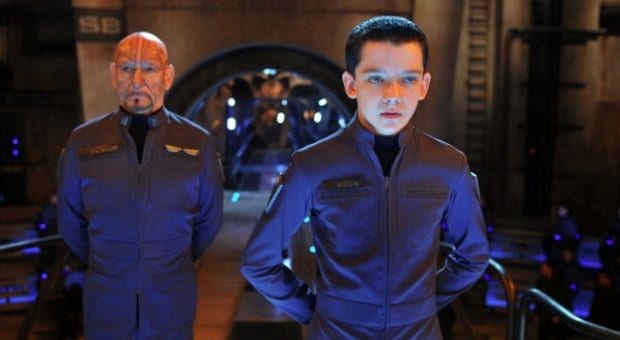Orson Scott Card is not just your run-of-the-mill Mormon homophobe.
Yes, he’s spoken out clearly against gay marriage, including in his 2004 essay “Homosexual ‘Marriage’ and Civilization,” where he asserts that “however emotionally bonded a pair of homosexual lovers may feel themselves to be, what they are doing is not marriage. Nor does society benefit in any way from treating it as if it were.”
And yes, such proclamations provide powerful fodder for the Skip Ender’s Game camp, which is calling for a boycott of the film adaptation of Card’s 1985 sci-fi novel, Ender’s Game, now playing in theatres.
However, those who have read Ender’s Game may detect some astonishingly queer threads by a possibly conflicted Card.
In the book, Ender — aged six when we meet him — is recruited and groomed by a futuristic government to lead Earth’s armies against an insectoid alien invader called the buggers. (Wisely, the term is not used once in the film, where the aliens are called Formics or occasionally referred to as bugs.)
The majority of the book takes place in a mostly male environment — a training school in space, where boys of all ages go through an elaborate, game-oriented boot camp. There is one girl present, but her gender is neither a plot point nor a cause for concern. One of only two significant female characters in the novel, she is never presented as an object of sexual attention.
Nor is anybody else, for that matter.
And that’s the first curious point: though many of Card’s boys are pubescent, it is striking that there is no mention of sexuality whatsoever.
Other than a pervasive awareness of the “bugger” as the enemy, no one jokes about, talks about, fantasizes about or has any sex at all. Nor is there any acknowledgment of any meaning other than insectoid for bugger. We are repeatedly told that Card’s boys sleep, and sometimes even fight with each other, naked. What of the unwanted teenage erection? The racy joke or homophobic taunt? What of covert wanking after lights out? All trace of normal human sexuality, queer or straight, has been swept under the carpet in the novel — as if sex simply doesn’t exist in the Ender’s Game universe.
Still, there are various ways in which sexuality creeps into the book backward. There is a kiss between boys, for example: it is offered as a religious greeting with the word salaam, but it is one of the novel’s most emotionally charged scenes. Individual religious observances have been all but suppressed in the world of the book, so the kiss becomes a guilty secret, exchanged in private and never talked about.
Then there’s a climactic confrontation between Ender and a rival, Bonzo, in the showers. Bonzo has come with his cronies to beat or kill Ender. The naked, vulnerable Ender taunts him and Bonzo decides to fight him one-on-one. To ensure equity in the fight, he strips naked, too. At this point, one of Ender’s friends, named Dink, rushes in and issues a startling proclamation, warning Bonzo that he will be helping the enemy if he beats up Ender: “If you touch him you’re a buggerlover.” (This remarkable sentence occurs on page 210 of the author’s definitive edition, for those who don’t believe me.)
Not surprisingly, the filmmakers have toned down the novel’s unacknowledged gay content. Besides the addition of many peripheral female characters, the boys sleep clothed, the male-on-male kiss is omitted, and the fight in the showers is altered so that Bonzo stays clothed. There is still a curious absence of sexuality, but it is explicitly explained by the insertion of a scene with a commanding officer warning the recruits, whose numbers include considerably more girls, not to engage in any sort of sexual behaviour.
And of course, the film makes no mention of buggers or buggerlovers anywhere.
There is some irony to the filmmakers’ decision to de-queer a text by someone who has so provoked the wrath of the queer community.
But a greater irony is that both the book and the movie end — spoiler alert! — with Ender coming to terms with the enemy he defeats, as he realizes that the war with the buggers stemmed from fear, misunderstanding and confusion. He becomes the buggers’ sole ally, travelling space in search of a world where the hive-queen “could awaken and thrive in peace.”
Funny that Card could come to terms with his book’s buggers yet maintain such rigid opposition to a segment of the human population. Maybe he should reread his own book.

 Why you can trust Xtra
Why you can trust Xtra


